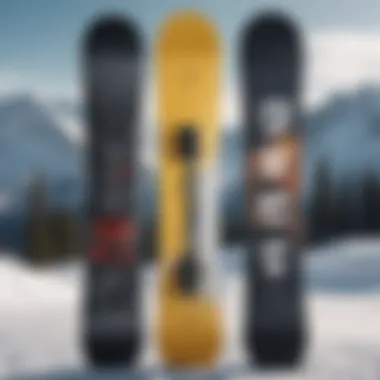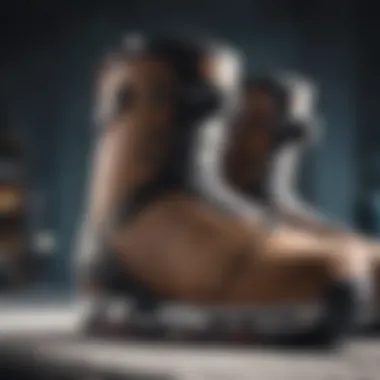Choosing the Right Snowboard Size: A Focus on 154


Intro
Selecting the right snowboard size is crucial for maximizing performance on the slopes. Many factors contribute to the optimal size, particularly with a length of 154 centimeters. Considering these factors can significantly enhance the riding experience, making it more enjoyable and effective.
Height, skill level, and weight are key aspects to consider. Each person's body type and riding style affect how a snowboard performs under varying conditions. Therefore, understanding these elements is essential for both novice and experienced snowboarders.
This article aims to dissect the intricacies of snowboard sizing, focusing on the 154 board. We will address common misconceptions, provide guidelines based on individual measurements, and offer insights relevant to the thriving snowboarding community.
Understanding Snowboard Sizing
When it comes to snowboarding, selecting the appropriate size of the board can significantly influence your experience, performance, and safety on the slopes. Understanding snowboard sizing is not just a detail; it is a foundational aspect of the sport. A well-chosen snowboard can enhance your riding comfort and style, while an ill-fitting one can lead to frustration and even accidents.
One of the crucial elements to consider when selecting a snowboard size is the rider’s height. Taller riders generally require longer boards, while shorter individuals benefit from smaller boards. This guideline is essential for achieving the right balance and control while riding. Equally, weight plays a significant role in sizing. Heavier riders should choose a board that can handle their weight more effectively, which is something often overlooked by beginners.
The right snowboard size can also make a notable difference in performance. For instance, a 154 snowboard is designed for specific height and weight ranges. Using a board that is not suited to your body type may restrict your ability to maneuver and perform tricks, ultimately impacting your overall enjoyment on the slopes. Considerations such as these underscore the importance of understanding snowboard sizing thoroughly.
The Importance of Selecting the Right Size
Choosing the right snowboard size is a matter of personal safety and optimization of skills. A board that is too short may lead to instability, especially at higher speeds. Conversely, a board that is too long can become cumbersome, hindering quick turns and making it difficult for the rider to maintain control. Knowing the correct size is, therefore, vital for performance.
Moreover, the impact of weight cannot be ignored. A rider with a higher weight might find a 154 snowboard to be advantageous if they are of suitable height. However, if the weight exceeds what the board can support, the performance diminishes. This balance between weight and size is crucial and should be something every snowboarder evaluates early in their riding journey.
Impact on Performance and Safety
The right snowboard size not only ensures better performance but is also essential for safety. Riding a snowboard that does not fit your body can lead to accidents. Snowboarding requires precision and control, and the proper size helps maintain these attributes.
When a snowboard fits well, it enables a rider to express their style confidently, whether that is executing jumps or navigating steep terrains. Additionally, a properly-sized board can help prevent fatigue. When riders struggle with an improper size, they expend more energy, increasing their risk of injury.
"A well-chosen snowboard enhances performance while prioritizing safety, making it a cornerstone of a successful snowboarding experience."
In summary, understanding snowboard sizing comprises multiple considerations, including rider height, weight, and personal safety. These factors work collectively to contribute to a fulfilling snowboarding experience, especially for those focused on making the most of the 154 snowboard slotted into the riding category.
In the next section, we will delve into the ideal height ranges for a 154 snowboard, taking a closer look at how height relates to board performance.
Ideal Height for a Snowboard
Choosing the correct height for a snowboard, particularly a 154 cm board, is fundamental for optimal performance. This specific board length caters to a range of rider heights, impacting not only how easily one can maneuver but also overall stability while riding. Understanding these factors can lead to a more enjoyable experience on the slopes. Selection of the right height is not just about comfort; it is about improving control and preventing injury.
General Height Guidelines
When it comes to snowboard sizes, height is a key factor. Typically, a snowboarder’s height can suggest which board length is suitable. A 154 cm board generally suits riders who are between 5'4" and 6'0" tall. This range is not strict but serves as a guiding principle for selection. Being at the lower end might lead to a softer flex, which is more forgiving for beginners; conversely, at the upper end, it can provide more stability at high speeds.
Selecting a board length often involves the board standing in line with the rider’s chin or nose when placed next to them. This visual cue helps in initial decisions but should be combined with other factors such as weight and riding style for a more precise fit. In addition, some shapes are tailored for specific riding styles, which can change these height recommendations slightly.
Weight Considerations
Weight plays an equally pivotal role when selecting a snowboard, in tandem with height. A snowboard's flex and responsiveness can be significantly altered depending on the rider’s weight. To derive the most benefit from a 154 cm board, it is essential to match the rider's weight with the board’s specifications to achieve the right balance and flexibility. Generally, the appropriate weight for a 154 snowboard falls in a range that usually extends from 125 to 175 pounds.
Too heavy a rider on a board not designed for that weight may result in sluggishness, while a lighter rider may find the board difficult to control. Therefore, checking the manufacturer’s guidelines regarding weight distribution is critical. It is also valuable to consider how the rider's weight shifts during various maneuvers.
"The balance between height and weight ensures the rider can extract maximum performance from the snowboard."


This combined approach allows snowboarders to customize their choices according to their specific needs, leading to better performance and safety while riding. Overall, understanding the implications of height and weight on snowboard selection is “much more” than just using a chart; it encompasses recognizing how these factors correlate to enhance the snowboarding experience.
Skill Level and Snowboard Size
Selecting the right snowboard size goes beyond just knowing your height. One of the pivotal aspects to consider is the rider's skill level. Understanding the correlation between skill level and snowboard size enhances the riding experience. It directly affects how well one can control the board, make turns, and respond to various terrains. Thus, acknowledging your skill level is essential when deciding on the size of your board, particularly the 154 snowboard length.
Beginners vs. Advanced Riders
Beginners often gravitate towards shorter boards. This is due to their increased maneuverability, which facilitates easier turning and control. A 154 snowboard can be accessible for riders just entering the sport, providing a stable yet responsive ride.
On the other hand, advanced riders typically prefer longer boards. This preference stems from their demand for speed and stability during high-performance rides. However, a 154 board might still work for some advanced individuals, especially those who favor tricks or park riding, where agility is crucial.
In summary:
- Beginners:
- Advanced riders:
- Shorter boards are typically better.
- Height and weight should still align with the board's specifications.
- Seek longer boards for stability.
- A 154 can be suitable if tricks are involved.
This highlights that personal choice, influenced by skill level, plays a key role in snowboard size effectiveness.
How Skill Affects Size Preference
Skill affects preference not only in board length but also in riding style. For instance, advanced riders have experienced various board types and learned how to handle different sizes under different conditions. Their preference may shift based on the specific terrain they encounter.
Additionally, a rider's confidence level significantly affects how they perceive size. An advanced rider may feel comfortable on a larger board and claim benefits such as increased speed and less chance of catching an edge. Conversely, a less experienced rider may feel overwhelmed by the same board size.
In practical terms, here are some factors influenced by skill:
- Rider Confidence: More confident riders may opt for a board outside their typical size preference.
- Terrain Familiarity: Knowledge of the riding terrain can lead to choosing an unconventional size due to prior experiences.
- Trick Requirements: Those focused on tricks, regardless of their skill level, might prioritize smaller boards for greater control.
Ultimately, as riders improve, their size preference may evolve. This evolution underscores the importance of self-awareness in riding skills.
"Choosing the right size snowboard is as much about understanding your growth as a rider as it is about knowing your current abilities."
A balanced understanding of skill level and board size greatly dictates the efficiency and enjoyment of snowboarding. Whether you are just starting your journey or have been mastering the slopes for years, recognizing how skill level affects size choice can lead to a more enjoyable experience.
Snowboard Shape and Its Influence
Understanding snowboard shape is essential for choosing the right board, particularly when discussing the 154 snowboard. The shape determines how the board responds to rider movements and conditions on the snow. A rider’s experience, performance and enjoyment on the slopes can be significantly affected by the board's design. Snowboards primarily come in two shapes: twin and directional, and each has specific uses and benefits based on riding preferences.
Twin vs. Directional Shapes
Twin-shaped snowboards are symmetric in design. This means they offer equal performance both regular and switch riding, which is useful for tricks and park riders. Many beginners prefer a twin shape as it simplifies turning and learning new maneuvers. On the other hand, directional boards are designed to be ridden primarily in one direction, making them better suited for all-mountain and backcountry riding. They typically have a longer nose and a shorter tail. This can assist in better floatation in powder snow, providing advantages for a rider who prefers steep terrains.
When selecting a board, it’s crucial to consider your riding style. A beginner snowboarder might find the twin shape more forgiving, while an advanced rider may want the performance benefits that come with a directional shape. Understanding these distinctions aids in making a better-informed choice.
How Shape Impacts Riding Experience
The snowboard's shape directly influences how it rides and handles in various conditions. For instance, twin boards offer a balanced experience when performing tricks, allowing for greater creativity and freedom on jumps and halfpipes. They provide stability and control, helping riders feel more confident during freestyle riding.
Directional boards, conversely, excel in carving on groomed runs and managing variable conditions. Their structure can influence the way turns are executed. A longer nose can help maintain speed and direction while minimizing drag when navigating fresh snow. It serves as a critical factor in entertaining advanced riders looking to enhance their performance in backcountry areas.


In summary, snowboard shape plays a vital role in overall experience and performance. Understanding the distinction between twin and directional shapes allows riders not only to match their boards with their snowboarding style but also to maximize their riding experience.
"Choosing the right board shape can be as important as selecting the right size. It shapes the whole experience on the slopes."
When deciding on a 154 snowboard, consider your skill level, preferred riding style, and typical conditions in your area. Each board shape offers unique benefits that can greatly enhance your time on the mountain.
Personal Preference in Snowboard Selection
When it comes to selecting a snowboard, personal preference emerges as a critical factor that can greatly influence overall riding enjoyment and performance. Each rider has unique tastes and comfort levels that influence their choice of board. The 154 snowboard length will serve different riders in various ways, depending on how their preferences align with the board's specifications. Understanding what you like can enhance your time on the slopes significantly.
One element to consider is the type of terrain where you plan to ride. Some snowboarders prefer hitting backcountry trails, while others might gravitate towards halfpipes or park features. A snowboard tailored to a specific riding style can amplify these experiences. For instance, park riders may favor a softer board for better maneuverability, while freeriders could lean towards something stiffer for enhanced stability at high speeds.
The choice of flex also falls under personal preference, influencing how the board feels underfoot. Not every rider enjoys the same level of responsiveness. Some may thrive on a reactive board that responds instantaneously to shifts in weight. Others might opt for a more forgiving model, offering a relaxed ride with less immediate feedback.
Equally important is how a board feels during actual riding. Trying out a snowboard, if possible, can inform a decision better than mere specifications. Personal comfort and confidence can considerably enhance performance.
"Choosing the right snowboard is as much about how it feels to you as it is about the numbers on the size chart."
Riding Style Considerations
Riding style often defines how and where a snowboarder rides. Each style has specific characteristics that necessitate different board features. Understanding your own style can assist in selecting the right snowboard.
For example, all-mountain riders favor versatility and thus look for a board that performs well across various conditions. However, those with a preference for freestyle riding may prefer a shorter and more flexible board for quick spins, jumps, and tricks. If you love carving, a longer board might match your needs better, providing stability during high-speed turns.
Choosing a board that enhances your natural style is crucial. If you find yourself often veering towards a specific type of terrain or trick, seeking a snowboard that falls within that category can improve your riding substantially.
Comfort vs. Performance Balance
Finding the right balance between comfort and performance is paramount when selecting a snowboard. While high performance on the slopes is desirable, comfort influences not just enjoyment, but also the level of confidence every rider feels. A board that performs exceptionally well but is uncomfortable can lead to fatigue and reduce overall effectiveness.
The right snowboard size, including the 154 length, can provide both comfort and performance. A comfortable board enables a rider to focus on technique and enjoyment rather than battling discomfort. Common comfort features include padded straps and contouring boots to maximize fit and reduce discomfort over long sessions.
Concurrently, performance relies heavily on the snowboard's ability to respond to shifts and maneuvers. The decision to prioritize performance over comfort can lead to intense rides, but also potentially to injury if the rider becomes fatigued. Therefore, integration of both elements often leads to a more gratifying riding experience.
In summary, considering your riding style and weighing comfort against performance can guide you to the snowboard that best suits your needs. Knowledge of these elements will not only assist in selecting a snowboard but also enhance your time on the slopes.
Common Misconceptions about Snowboard Sizing
Understanding snowboard sizing is riddled with common misconceptions that can mislead both novices and experienced riders alike. These misunderstandings can significantly impact a rider’s overall performance and enjoyment on the slopes. This section aims to clarify these myths while fostering a better understanding of what truly matters in snowboard sizing.
Myths and Facts About Board Length
One prevalent myth is that a longer snowboard is always better for larger riders. Many believe that the size of the snowboard should be based solely on height. In reality, board length is influenced by several factors, including weight and riding style. For example, if a heavier rider uses a shorter board, they may experience difficulties with stability and control.
A general guideline can be derived from height measurements but should not exclusively dictate the choice of snowboard length. Here are some key points to consider:
- Performance Needs: Shorter boards are often favored by freestyle riders for better maneuverability, while longer boards provide stability at higher speeds for freeriders.
- Riding Style: A rider's preference for tricks or speed can alter what length is practical. This means that even if a rider is tall, they may opt for a shorter board if they ride primarily in a park setting.
- Manufacturer Differences: Different brands may have varying sizing charts. Therefore, it's essential to consult specific recommendations from brands like Burton or K2.
This nuanced approach can help in selecting an appropriate board length rather than sticking to myths.
The Role of Flexibility in Size Selection
Another common myth revolves around flexibility. Many individuals erroneously judge snowboard flexibility only by their height or weight. However, flexibility plays a critical role in how a board performs during different conditions. Soft boards are typically easier to maneuver, making them ideal for beginners or park riders. In contrast, stiffer boards provide greater stability at speed, which is advantageous for advanced riders navigating varied terrain.


When considering flexibility, think about:
- Riding Terrain: Different terrains require different flex patterns. A softer board may suffice for groomed runs, while a stiffer design can handle powder well.
- Personal Preference: Ultimately, individual comfort can dictate what level of stiffness one might prefer. Flexibility can enhance control and response, which is vital for safe riding.
Riders must take these factors into account when selecting their snowboard. By dispelling these misconceptions, riders can make informed choices that align with their style and needs, enhancing their snowboarding experience on the slopes.
Finding the Right Fit: Practical Tips
Choosing the right snowboard size is crucial for maximizing your experience on the slopes. Selecting a board that fits your height and style can greatly enhance control, stability, and comfort. One of the key aspects of this selection process involves understanding practical tips to ensure you find a board that truly meets your needs. This is particularly relevant when discussing the 154 snowboard length, which serves a specific height range and rider type. Practical tips can guide both a novice and a seasoned snowboarder in making educated decisions.
Consulting Size Charts
Snowboard manufacturers often provide size charts that can serve as a foundational reference point. These charts outline recommended board lengths based on rider height and weight, offering a useful starting point for determining the right fit. When consulting these charts, it is essential to consider not only your height but also your weight. The relationship between these factors plays a significant role in effectively utilizing a 154 snowboard.
To get the most accurate assessment:
- Measure Your Height: Start by standing straight against a wall and noting your height in centimeters or inches.
- Weigh Yourself: Accurate weight measurements can influence the level of flex your board needs.
- Refer to Brand-Specific Size Charts: Each brand may have slight variations. Ensure you look at the size chart for the specific board you’re considering.
Using these size charts provides insights into how a 154 snowboard might perform under your weight. It can also highlight whether adjustments may be needed depending on your riding style.
Trying Before You Buy
The practical experience of actually trying a snowboard cannot be overstated. Testing a board firsthand allows you to assess how a 154 snowboard feels under your feet and whether it matches your preferences in terms of comfort and responsiveness. Many shops offer rental programs where you can try before you commit to a purchase. This should not be overlooked, as it leads to informed choices that align with your personal riding style.
When trying a snowboard, pay attention to:
- Flexibility: Flex plays a critical role in how a board reacts to your movements. A stiffer board can provide stability at high speeds, while a softer board may be more forgiving for beginners.
- Control: As you ride, assess if you feel in control. Can you easily turn and maneuver?
- Comfort: The board should feel comfortable underfoot; discomfort could indicate a size mismatch.
Ultimately, visiting shops and trying a range of snowboards will give you a realistic sense of what suits you best. Remember, the more you engage with different boards, the clearer your preferences will become.
"Finding the right snowboard isn't just about length; it's about how that length works with your style and body type."
By focusing on consulting size charts and trying boards before buying, riders can make well-rounded decisions. Practical tips assist in finding that ideal snowboard fit, enhancing both performance and enjoyment on the slopes.
Finale: Making an Informed Decision
Choosing the right snowboard size can greatly affect your experience on the slopes. It is crucial to take various factors into account to achieve optimal performance and comfort. A well-fitted snowboard enhances not only the enjoyment of riding but also contributes to your safety. The focus on a 154 board length requires careful consideration, particularly regarding a rider's height, weight, and skill level.
Making an informed decision involves synthesizing how these elements contribute to an effective riding experience. Understanding the interplay between stature and board length allows riders to harness their physical attributes most effectively. This article positions itself as a resource to clarify these vital aspects, encouraging readers to make thoughtful and responsible choices when selecting equipment.
The key takeaway is that the snowboard's size and the rider’s physical characteristics must align for the best results. This necessitates thoughtful examination of not only height but also factors like weight. Moreover, skill level plays a significant role in determining the appropriate size. Each rider's unique preferences must also be considered for a truly satisfying ride experience.
"The right board can elevate your experience, while the wrong choice may lead to frustration or even injury."
Recap of Key Factors
To recap, several key factors should be remembered when deciding on a snowboard size:
- Height: Reference height guidelines are important for selecting a suitable board length.
- Weight: A rider's weight influences how a board flexes during use.
- Skill Level: Different skill levels demand different board characteristics.
- Riding Style: Freestyle, freeride, and all-mountain styles may affect board preferences.
- Comfort: Personal comfort ensures that enjoyment prevails over difficulty while riding.
Each of these factors interplays with one another, making it essential to consider them collectively rather than in isolation.
Encouraging Responsible Choices
Making responsible choices in snowboard selection can help avoid frustrations or hazards on the slope. Here are some suggestions:
- Consult Size Charts: Manufacturer charts provide necessary size parameters based on height and weight.
- Test the Board: Whenever possible, try different sizes and styles to best understand your needs.
- Ask Experienced Riders: Advised insights from seasoned snowboarders can lead to improved decisions.
- Stay Informed: Continually educate yourself on new technologies and techniques in snowboarding. Understanding emerging trends in board designs and materials may inform future purchases.
Ultimately, an informed decision engages the rider in an enjoyable activity, reducing potential for regret and enhancing overall satisfaction. Understanding the importance of fitting your board to your attributes creates a tailored experience in the sport.







